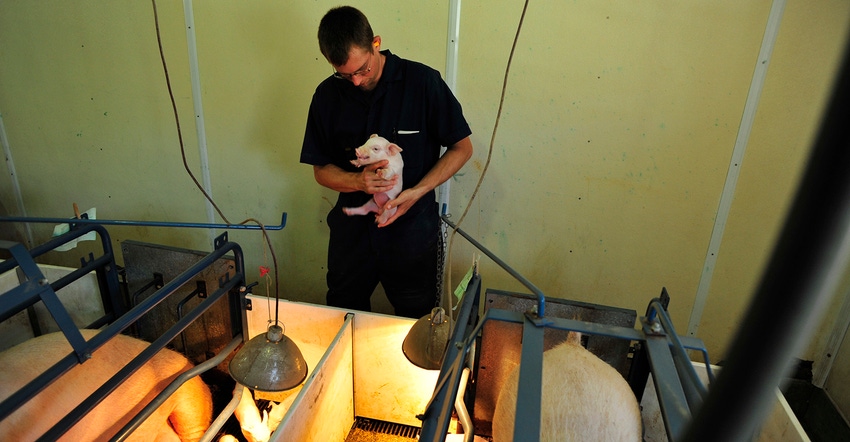Researching best effect of anesthesia for piglet castration
Researchers from Aarhus University will examine advantages and disadvantages of different anesthetics used in piglet castration.
November 19, 2019

Today, almost all Danish male piglets are castrated between the age of 2 and 7 days in order to avoid boar taint in the meat. Before 2018, castration was performed without the use of anesthesia. As from Jan. 1, 2018 — and having completed a training course — Danish farmers were given the opportunity to anaesthetize their piglets prior to castration; and as of January 2019, a general industry agreement requires that piglets are anaesthetized prior to the procedure.
As a part of Aarhus University’s agreement with the Ministry of Environment and Food of Denmark on science-based policy support, The Danish Veterinary and Food Administration has requested researchers from the university to examine if the method recommended today will provide the best possible pain relief, or whether it may be adjusted to improve pain relief and welfare.
Less pain
Working with local anesthetics is new to Danish farmers. They are familiar with vaccinations and injections in case of diseases, but these are simpler procedures compared to administering local anesthetics to specific parts of the body. In order for farmers to administer local anesthesia, The Danish Veterinary and Food Administration requires that they complete a training course in a method already used in Sweden, and now recommended in Denmark: the anesthetic is administered in skin, testicle and at the spermatic cord. Post Doc Hanne Kongsted, Department of Animal Science at Aarhus University, explains that the researchers will study the entire castration procedure. "We apply a holistic approach. We know that it hurts, when you castrate a pig without anesthesia. However, applying anesthesia introduces other painful and stressful events to the pigs. Nobody wants to introduce a method that implies the same or potentially even more severe pain and adverse effects on the welfare, than castration without anesthetics. Overall, we aim to describe the least painful and stressful method in order to improve the welfare of the pigs."
Three methods are tested
Based on interviews with farmers, veterinarians and representatives from the pharmaceutical companies producing the drugs licensed for this purpose in Denmark, the researchers have so far identified three different methods to be examined.
"The Swedish method" (described above), which is officially recommended; a simpler procedure where the anesthetic is injected only into the testicle; and finally, a method where the anesthetic is injected into the testicle and the skin.
Another aspect of the study is the interval from administration of the anesthetic and until the castration procedure begins. Today, the recommended interval is five minutes; however, there is no documentation as to this interval — how many minutes are sufficient and how long can you wait. This knowledge is important in practice, as the farmer will often have many piglets to castrate on a given day.
Anesthesia makes a difference
Interviews with farmers and veterinarians experienced with applying anesthesia prior to castration suggest that anesthesia has a positive effect for the pig when castrated. However, a number of unresolved questions remain. For instance, Danish farmers are required to use anesthetics based on the active drug procaine, while most studies in the literature were carried out using lidocaine.
"The professionals that we have interviewed, and who have practical experiences with local anesthesia and castration, unequivocally state that anesthesia does make a positive difference. The piglets seem calmer; and they do not scream or move quite as much. We hope to identify a method that is more simple than the current practice, and with a reduced risk of mistakes. Farmers are busy, and if it would be possible to apply only one injection and know that the piglet does not feel pain, this would be a great relief in the herds," Kongsted explains.
In Denmark, two different types of anesthetics have been approved for local anesthesia in piglets. The existing guideline for anesthesia does not consider the difference. The study will establish whether there is any reason to make separate recommendations for the timing of incision and the volume of drug used. The recommended "Swedish method" is performed in Sweden using lidocaine, a drug not approved for use in Denmark. According to the researchers' interviews with professionals, who have experiences with both procaine and lidocaine, the effect of lidocaine is better.
Experimental study initiated
In order to gain knowledge about the applicability of the different methods, experimental studies will be carried out during the next three years.
Source: Aarhus University Danish Centre For Food and Agriculture, which is solely responsible for the information provided, and wholly owns the information. Informa Business Media and all its subsidiaries are not responsible for any of the content contained in this information asset.
You May Also Like



